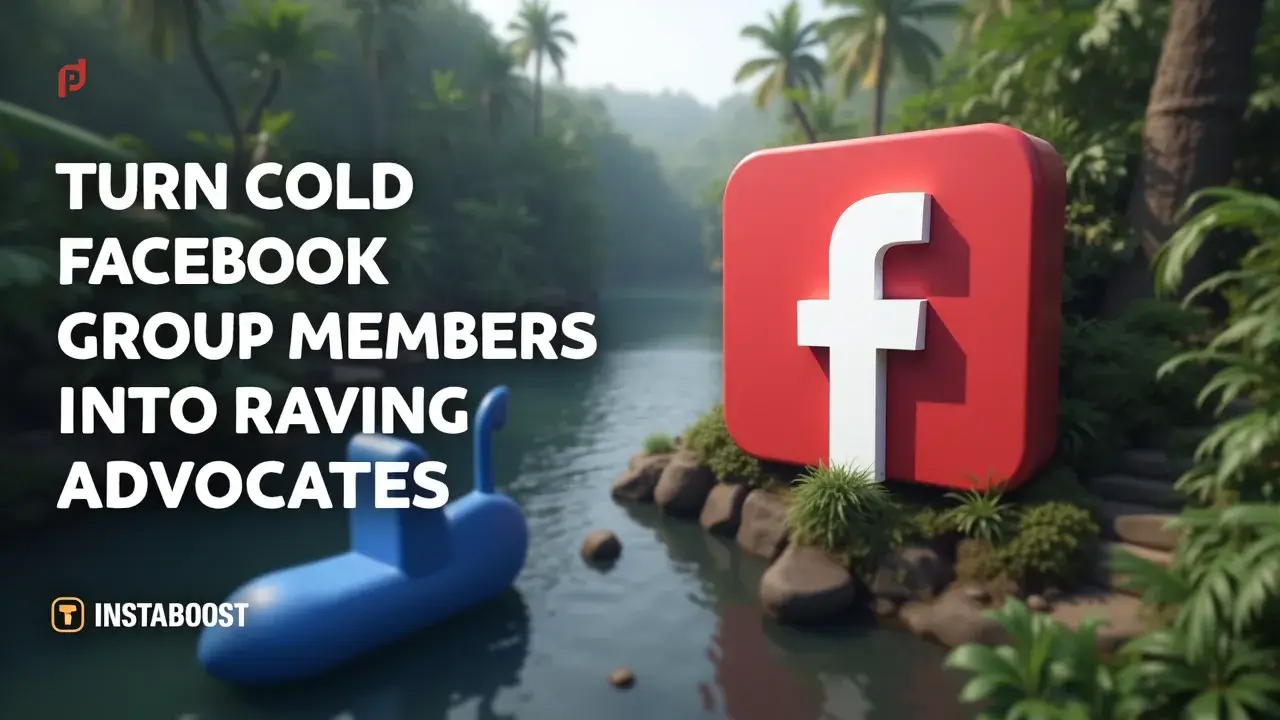How to Turn Cold Facebook Group Members Into Advocates?
Cold Facebook group members can become advocates by defining one simple success marker for the first week, such as consistent comment replies. Steady prompts and clear wins give members easy reasons to interact and return. Over a month, repeated micro-engagements compound into trust and stronger loyalty. Choosing a clear first-week metric and building on it provides a smart path to sustained community momentum.
From Bulletin Board to Living Room
Cold Facebook group members aren’t apathetic; they don’t see a reason to lean in. Most groups feel like noticeboards – announcements, promos, stray questions – so people pass by, glance, and keep moving. Shift the feel to a living room and the behavior changes. People take cues from the host’s tone, the rhythm of conversation, who does what, and whether showing up unlocks something useful for them. This guide focuses on the small shifts that turn a quiet crowd into people who show up for each other. We’ll trade blasts for pull: invitations that make it easy to reply, a steady cadence that builds familiarity, and roles that bring out the quieter experts without putting them on a stage.
If you’ve been chasing “engagement,” try thinking in terms of momentum – small, dependable interactions that build trust and lead to referrals. You’ll get practical tools: conversation arcs that warm lurkers in three touches (a low-stakes reaction, a short reply, a simple share), prompts that produce real social proof (screenshots of outcomes, short wins with context), and a posting system that uses native formats to spark member-to-member threads instead of comments aimed only at the host. We’ll also name common friction points – fuzzy norms, messy topics, host-at-the-center energy – that slow everything down and make the algorithm treat your space like background noise.
The aim isn’t louder posts; it’s better coordination. When you design for contribution – clear on-ramps like “Introduce yourself with one current goal,” rotating spotlights like “Member of the Week,” and lightweight asks like “Drop your template, others will add edits” – members start to co-author the space. The group shifts from a feed to a working system. You’ll learn how to turn one-off likes into steady growth, write posts that travel with shareable hooks, and build participation that compounds into advocacy. It’s a practical playbook for warming up lurkers and creating pull that keeps going on its own, even when you step back for a day or two and get more out of your Facebook content, then return to find conversations carrying forward without you.

Prove You’re a Host, Not a Hall Monitor
I’ll take a hard-earned insight over a catchy headline any day. In a Facebook group, credibility isn’t a vibe; it’s a track record people can see. Start by showing your work: every two weeks, share a short “what worked, what didn’t” note with basic numbers – reach, comments, saves, and the one that really shows advocacy: member-to-member replies. When people see you measuring the right things and adjusting, the quiet lurkers start to lean in. Make your expertise easy to use. Pin a living “house playbook” that lays out roles (host, greeter, synthesizer), the meeting cadence, and a concrete example of what a strong post looks like here.
When the rules of the living room are written down, people don’t have to guess how to pitch in. Earn authority by borrowing it carefully. Host 20-minute office hours with one practitioner at a time, then turn each session into a short field note – no hero worship, just the steps they take and how someone else can try it. Show receipts with links to before-and-after posts and member outcomes, not vague praise. Make transparency a habit. If you remove a promo or close a thread, say why in a sentence and point back to the playbook.
That consistency builds trust faster than any welcome post. The quiet experts notice, start contributing, and others follow their lead. That’s the flywheel: simple experiments, public debriefs, clear roles, and visible standards. It’s how cold members turn into advocates without any hype, and how a bulletin board starts to feel like a living room people tell their friends to check out and see for themselves and get more Facebook followers fast.
Design Weekly Loops, Not One-Off Posts
You don’t need more tips. You need traction. People in a cold Facebook group warm up when there’s a simple, repeatable reason to show up, do something small, and come back. Set a weekly loop with three beats: Prompt, Proof, Pass-the-Mic. Monday: post one clear prompt with a specific, low-effort action (“Share your one-sentence offer; reply to one person with a tweak”). Wednesday: share proof from the last round – the most improved post, the sharpest critique, a quick before-and-after – and tag the folks who contributed.
Friday: hand the thread to a member (“Ana hosts hiring week: post your job, she’ll audit your listing”). This rhythm teaches the habit: people expect to pitch in, see results, and get a spotlight. Track one thing: member-to-member replies per thread. It’s the best signal that the group is moving from a bulletin board to a living room, and it grows over time. If you need material, use native formats: a carousel for proofs, a short reel for “audit highlights,” and a plain text prompt when speed matters. Keep a running list of prompts that work and rotate them each month; familiarity lowers friction.
The plan is intentionally simple – and it beats hero-posts and chasing the algorithm. Give it four weeks and you’ll see replies gather around the same beats, new voices jump in, and your Facebook group pull people back on schedule. That’s traction – turning cold members into advocates without posting more, just better. Label the cadence so newcomers recognize the engine, and mention “Facebook engagement” as the throughline without implying it’s about hacks, the way some folks confuse genuine replies with vanity tactics like buy likes for Facebook stories, and keep the focus on conversations that compound.
Challenge the “More Posts = More Warmth” Myth
Momentum can hide problems. A busy feed can look fine while trust slips. So resist the urge to post more or try “engagement hacks.” In cold Facebook groups, silence isn’t the only issue; lots of noise without back-and-forth is risky too. If Monday’s prompt pulls 40 comments but 90% are from you, that’s dependency, not advocacy.
Ease off the output and raise the bar for how people interact. Try a two-week constraint: fewer posts with a sharper point, and grade threads by member-to-member replies, saves, and restarts – like when someone revives last week’s thread with a new example, and ignore quick-fix detours like purchase Facebook views online because they mask the very signals you need. If a post only works when you keep nudging it, retire it. If a member’s answer pulls in three follow-up questions, feature them in next week’s Pass-the-Mic slot. That’s how people become advocates: give them room to solve each other’s problems, and be the host who sets up useful collisions, not the broadcaster filling space.
And stop reading warmth as speed. Fast comments often mean low effort. Look for slow signals: a late case study, a bookmarked post, a cross-thread reference – “as Maya said in the pricing thread.” Those show a shared language forming. A simple test: swap one scheduled post for a “Leave one, take one” exchange – templates, scripts, or screenshots. Your job is to weave replies together, not stack prompts. If the thread runs for 48 hours without you, keep it. If it stalls the moment you step back, that tells you more than another like: the loop needs reworking, not more volume.
Make It Their Room, Not Your Stage
You’re not here to stick the landing; you’re here to reflect what’s working back to the group. The loops and the restraint aren’t about applause; they’re about passing things on. The last step is straightforward: say out loud the behaviors you want to keep seeing when you’re not in the room. Move from being the engine to being the framework. Write one post that spells out the group’s house rules for momentum – Prompt, Proof, Pass-the-Mic – pin it, and tag three people who already do it.
Then set a new default: you’ll keep the rhythm, but members run the beats. Assign small, specific roles that rotate weekly: Prompt Host, Proof Curator, Mic-Passer. Keep the role cards simple and concrete: “Post the Monday prompt at 9 a.m. and reply to the first five comments with questions, not answers.” Add one metric that rewards advocacy over raw activity: member-to-member replies per thread; it’s the kind of signal that grows when people echo each other’s best moves and, without fanfare, helps you grow your Facebook audience with shares simply by making the room worth returning to. When that number climbs, point to the people who made it happen, not the post itself.
End each loop with a handoff: “Next week’s prompt is Elena’s. She picked it.” That’s how a quiet Facebook group turns into people who look out for each other – through shared ownership, not your show. If a thread takes off, don’t jump in with the clever take; ask the starter to summarize what worked and tag three voices you didn’t hear. Your quiet KPI is replacement rate: how often a member picks up a job you used to do. That’s the mirror. When the cadence holds without you, you’ve built a living room, not a bulletin board – and that’s the finish line that actually keeps going.















